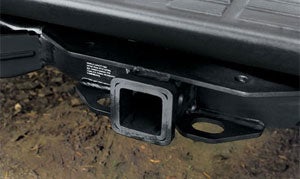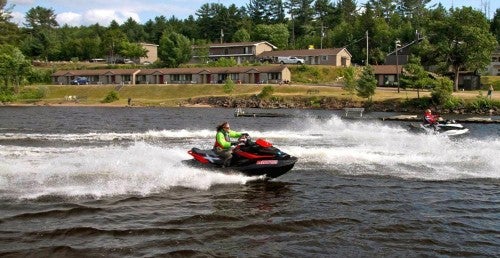Safe Trailering for Personal Watercraft
What to look for in tow vehicles, hitches, trailer balls and more
My very first stand-up Jet Ski went through the hatchback of my father’s car. You wouldn’t try that with today’s average PWC. Modern craft are typically three-seaters, and always heavy, making a trailer almost a must in any PWC purchase.
The trailer, however, is just one portion of the towing equation. Often overlooked are those other towing details, stuff like carrying capacity, hitch and ball styles, electrical connections, even whether or not your car, SUV or truck is up to the task at hand.
Before you take off down the road, consider the following suggestions…
Appraise your choice of tow vehicle
Today’s personal watercraft are heavy, and as such they need a suitable tow vehicle to haul them down the road. Look in your car’s owners manual; you should find a section on trailering. It will spell out the maximum trailer weight for your particular vehicle and engine combination. If you own a smaller car, be prepared. The maximum weight can be as low as 1,000 pounds. Even a sturdy-looking SUV might call for things like a heavy-duty transmission cooler. Check out your owner’s manual, and make sure your warranty won’t be voided by hauling too big a load.
Add up your entire load

Trailers are rated in terms of carrying capacity (how much they can safely haul), Gross Vehicle Weight Rating (the carrying capacity plus the weight of the trailer itself), and tongue weight (the downward force exerted on the hitch ball by the trailer coupler). Of the three, Gross Vehicle Weight Rating is perhaps most important, and often most misunderstood. Why? Buyers often tend to consider only the PWC itself, and neglect to consider all the extras that go along with it, such as a tank of fuel, riding gear, and any extras loaded into the storage compartments. Always select a trailer hitch in line with your trailer’s GVWR. Remember, it’s always better to have more hitch than necessary, rather than haul an overly heavy load with a hitch designed for lighter duty. A stronger hitch will also grow with you should you buy a larger machine, or haul a friend’s craft to the water.
Understand hitch class ratings

Class I trailer hitches are rated to carry 2,000 pounds; Class II 3,500 pounds; and Class III, 5,000 pounds. Tongue weight ratings are typically 10% of the trailer’s carrying capacity. While a Class I hitch might be all you really need for your particular setup, the difference in price between a Class I and Class III hitch is often minimal. If your vehicle can handle the potential loads, opt for the heavier-duty model, which offers an added degree of safety and, again, prepares you to haul more than just your own craft in a pinch.
Choose the hitch style that works best for you

A fixed tongue hitch has the ball permanently attached to the hitch. In contrast, a receiver-style hitch uses a removable drawbar, allowing you to remove the hitch from the vehicle when not in use. Receiver hitches also offer the advantage of easily swapping out differing size balls, or using individual arms which drop or raise the trailer attachment height. Whatever style you choose, make sure it mounts directly to the car’s frame by either welded connections or bolts. Be wary of combination bumper/frame hitches; they may be adequate for lighter loads, but negatively affect most modern “5 MPH” bumpers, designed to flex in response to a mild impact.
Check out the size of your balls…literally
While a 1 7/8” ball is typical for Class I hitches, and 2” the norm for Class II and III, PWC trailers tend to bounce between the two sizes, not always following any particular rhyme or reason. Only your trailer’s coupler should make the decision here; it will be stamped with the correct size. Never, in any circumstance, use a ball that is smaller than what the coupler calls for, as it could allow the coupler to vibrate loose. Solid steel trailer balls are also highly recommended for any towing; the weight-bearing capacities are typically stamped on top of the ball itself.
Don’t overlook the final connections

Don’t forget the final steps that complete the towing process. Connect your trailer’s safety chains to the appropriate spots on your hitch. Safety chains should be criss-crossed under the tongue in order to provide a cradle should the tongue become disconnected. Connecting your trailer lights is also a must; make sure they work, and if not, find the cause. It’s not safe to trailer without brake, turn, and running lights. If they need replacing, go for LEDs; they’ll last longer and prove more worry-free than incandescent bulbs. Some trailers also feature a surge-brake cable that activates the brakes in the unlikely event the trailer gets unhitched. Hook it up to keep you, your craft, and others on the road, safe.
Related Reading
The No-Stress Way to Launch A PWC at the Ramp
2010 Sea-Doo ADVANCED TEC iCATCH I Trailer Review
Get PersonalWatercraft.com in your Inbox!
Like PersonalWatercraft.com on Facebook
Comments
Most Popular

2025 Yamaha JetBlaster PRO 2-Up Review

2024 Kawasaki Jet Ski STX 160X Review

Remembering the Sea-Doo XP

Whatever Happened to the Wetbike?

2025 Yamaha JetBlaster Review












 Your Privacy Choices
Your Privacy Choices